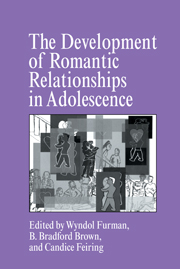Book contents
- Frontmatter
- Contents
- Contributors
- Foreword
- Acknowledgments
- 1 Missing the Love Boat: Why Researchers Have Shied Away from Adolescent Romance
- Part I Processes in Romantic Relationships
- Part II Individual Differences in Romantic Relationships
- 6 Capacity for Intimate Relationships: A Developmental Construction
- 7 Rejection Sensitivity and Adolescent Romantic Relationships
- 8 Sex, Dating, Passionate Friendships, and Romance: Intimate Peer Relations Among Lesbian, Gay, and Bisexual Adolescents
- 9 Gender Identity and the Development of Romantic Relationships in Adolescence
- Part III The Social Context of Romantic Relationships
- Part IV Conclusion
- Author Index
- Subject Index
6 - Capacity for Intimate Relationships: A Developmental Construction
Published online by Cambridge University Press: 05 October 2014
- Frontmatter
- Contents
- Contributors
- Foreword
- Acknowledgments
- 1 Missing the Love Boat: Why Researchers Have Shied Away from Adolescent Romance
- Part I Processes in Romantic Relationships
- Part II Individual Differences in Romantic Relationships
- 6 Capacity for Intimate Relationships: A Developmental Construction
- 7 Rejection Sensitivity and Adolescent Romantic Relationships
- 8 Sex, Dating, Passionate Friendships, and Romance: Intimate Peer Relations Among Lesbian, Gay, and Bisexual Adolescents
- 9 Gender Identity and the Development of Romantic Relationships in Adolescence
- Part III The Social Context of Romantic Relationships
- Part IV Conclusion
- Author Index
- Subject Index
Summary
The advent of romantic relationships is a hallmark transition of adolescence. Images of the sudden onset of preoccupation with the other, shyness and self-consciousness, awkwardness in interactions, and sexual awakening suffuse popular treatments of the topic. In developmental perspective, however, romantic relationships are embedded in fundamental human motivations to form and maintain close relationships (Baumeister & Leary, 1995; MacDonald, 1992) and in a meaningful progression of relationships across the life course (Ainsworth, 1989; Feeney & Noller, 1990; Furman & Wehner, 1994). Early caregiver-child relationships, peer relationships in preschool and middle childhood, and close mutual friendships in adolescence all potentially contribute to the behavioral patterns and emotional orientations that mark a relationship as romantic.
Romantic relationships are distinct from these forerunners in many ways. In contrast to the kinship or legal bonds that commonly circumscribe caregiving relationships, romantic relationships are voluntary and symmetrical. Literary and popular portrayals frequently depict as tragic the attempts of parents, other authority figures, or social conventions to coerce, nullify, or otherwise render involuntary the selection of a romantic partner. In contrast to caregiving relationships, in romance each partner is dependent upon the other, whereas the dependency of child on caregiver is asymmetrical. In contrast to friendships, the reciprocal dependency of romantic partners is typically greater and more extensive.
- Type
- Chapter
- Information
- The Development of Romantic Relationships in Adolescence , pp. 125 - 147Publisher: Cambridge University PressPrint publication year: 1999
- 137
- Cited by



